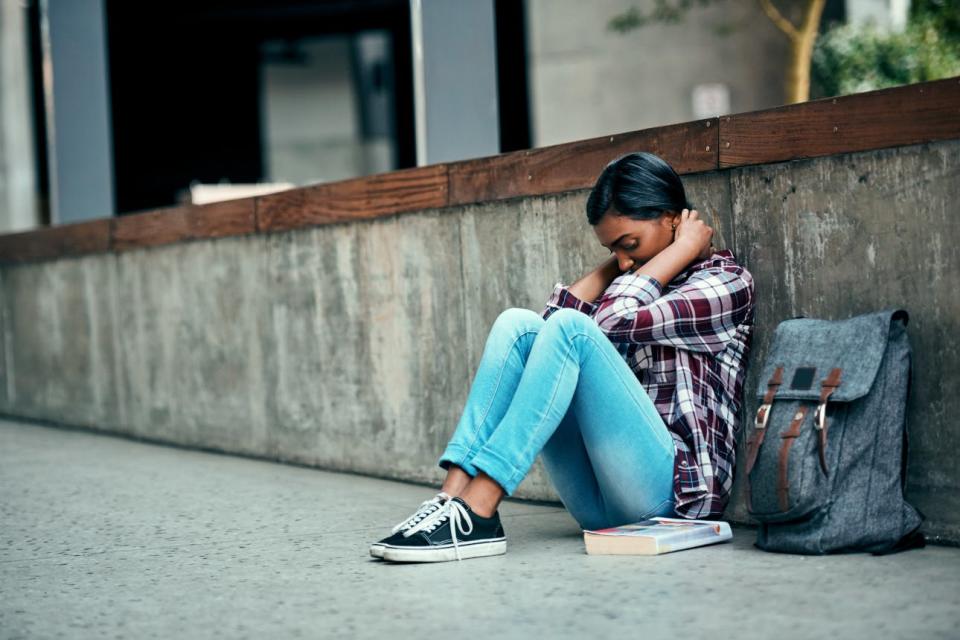How to Tell the Difference Between an Emotional Slump and Clinical Depression
Depression and other aspects of mental health are being discussed more openly now than ever before, thanks in part to celebrities like Michelle Williams, Demi Lovato, and Kristen Bell sharing their own experiences. But its long-held status as a taboo topic means that not everyone understands the symptoms of depression when compared to the kind of temporary emotional low that everyone goes through sometimes. Here’s how to tell if you’re experiencing a temporary slump or a form of clinical depression, and advice for approaching both.
What is depression?

Having clinically diagnosed depression (also referred to as major depression) is not the same as feeling sad or down, although these emotions can be part of it. “Depression is much more than just an extended, deep sadness; it is an extremely complex disease with a set of challenging symptoms that are the result of biological problems in the brain,” explains Dr. Daniel G. Amen, psychiatrist, author, and founder of Amen Clinics. “Many people have tried to explain this feeling; some say they now feel trapped and alone when they used to be so happy.”
Dr. Brian Cassmassi, a psychiatrist and mental health consultant in Los Angeles, explains that according to the Diagnostic and Statistical Manual of Mental Disorders (currently on its fifth edition, shorthanded as DSM-5), which is the resource professionals use to diagnose mental health conditions, a person has to meet certain criteria after two weeks of feeling sad most of the day, every day, in order to be diagnosed with clinical depression. “The criteria include fatigue, changes in appetite, changes in sleep, a sense of apathy, and a sense of worthlessness or guilt,” he says. In addition, Dr. Cassmassi expands, the person might think about death or contemplate suicide. Ginger Houghton, a therapist and licensed social worker who owns Bright Spot Therapy, adds that another key sign of depression is when “people start struggling in different areas of their life, including at work, at home, in relationships, and in daily functioning.” It’s also important to note, she says, that these changes “can’t be better explained by a medical issue (for example, a thyroid issue) or a substance use issue.”
What’s the difference between clinical and temporary depression?

The most significant indicators that you’re going through a major depression rather than a more transitory form are the range of symptoms, how often you’ve had them, and for how long. “With major depression, these symptoms are typically present for more than two weeks, with at least five symptoms present nearly every day,” explains Dr. Barbara Nosal, PhD, a therapist and chief clinical officer of Newport Academy. “For a diagnosis of temporary depression, only two depressive symptoms need to be present.” In that two-week period, if you can still find enjoyment from hobbies and things that have made you happy in the past, you might not have clinical depression. “With sadness, a person can still experience joy out of a TV show or activity or find relief from feelings of guilt after making a mistake,” Houghton explains. “In depression, it can become very difficult to get enjoyment out of any activities, and guilt or worthlessness can feel unshakable.”
Another sign that you have major depression is that it often comes on with no apparent triggers (although this isn’t the case 100 percent of the time.) “Brief depressive episodes usually have easier-to-spot triggers, where major depressive episodes can also occur without a readily identifiable trigger, especially for those with a history of repeated bouts of depression,” elaborates Dr. Cassmassi. Dr. Nosal points to “the loss of a loved one, the end of a relationship, or the loss of a job,” as possible factors in temporary (or “situational”) depression, as well as certain medications, “colder weather, which can trigger seasonal depression, or quitting an addictive habit, such as smoking.” That said, major depression can also be brought on or triggered by deeply impactful events. “Clinical depression can be triggered by social isolation, major life changes, trauma as a result of abuse, or conflicts in personal relationships,” says Dr. Nosal. And some people are simply more prone than others: “The severity of the trigger’s impact depends greatly on the person’s existing coping methods and the significance of the stressor,” Dr. Cassmassi tells us.
One of the most directly dangerous aspects of both situational and clinical depression are suicidal thoughts, says Dr. Cassmassi. “While passing thoughts of suicide (‘I wish I weren’t here’ or ‘I wish I weren’t going through this right now’) are common to both, having more defined thoughts of suicide would be a major warning sign for clinical depression that needs treatment,” he advises. “Once someone starts having fantasies of suicide, or especially if they start planning out means, then they have certainly moved beyond just a ‘low period’ or doldrums.” There is no bad time to seek treatment for depression, and no set of conditions you have to meet before you “deserve” treatment. But if you are considering suicide, even in the abstract, this is a strong sign that you need immediate professional help.
What You Can Do

Treating clinical depression is not a case of “cheering someone up” — it requires expert help. Dr. Nosal identifies a few types of therapy designed to help patients with major depression: “Cognitive Behavioral Therapy (CBT) helps clients identify self-defeating thoughts and assumptions that make life more difficult and provides valuable insight for healing. Dialectical Behavioral Therapy (DBT) offers specific skills, such as mindfulness and emotional regulation. Motivational Enhancement Therapy (MET) helps resolve any initial resistance to treatment. Designed specifically for adolescent depression, Attachment-Based Family Therapy (ABFT) repairs the family system and the parent-child relationship.” Therapy is also a good option if you’re going through a short-term depression. “Even if the depressive episode is temporary, a skilled therapist can help build coping skills so that the person is better adapted to handling the next stressful event or emotional down-period,” Dr. Cassmassi encourages.
You may also find medications work for you to help restore the ability to function in (and even enjoy) your daily life. “Some stressful events (e.g., a near-death experience) might cause increased anxiety attacks or insomnia that a physician might then give a brief, small supply of anti-anxiety medications to help for the short term,” says Dr. Cassmassi. “Major depressive episodes that are longer lasting or recurrent may benefit from antidepressants.” There are different types and dosages, so work with a doctor you trust to find the best solution for you.
While clinical depression requires consistent professional attention, people who are experiencing a temporary kind, or those not currently in a depressive episode, can often find help resisting it with a few lifestyle practices (potentially in conjunction with therapy and medication, depending on what works for you). “Sleep is closely related to mental health, so getting enough quality sleep is paramount,” asserts Dr. Nosal. “Proper nutrition, in particular, decreasing sugar intake, also supports mental health. A large body of research shows that physical exercise and contemplative practices, such as yoga and meditation, are effective in lifting mood.” There is no quick fix or magic bullet for dealing with depression of any kind. But know that it’s not your fault, there are plenty of people who have been there too, and they are rooting for you.
How have you or a loved one managed depression? Share your experiences with us @BritandCo.
(Photos via Getty)
You Might Also Like


